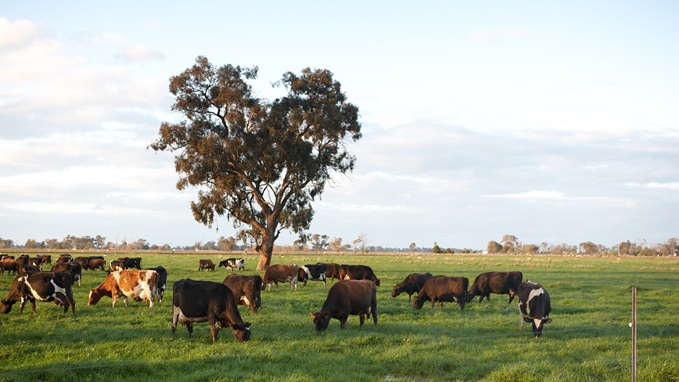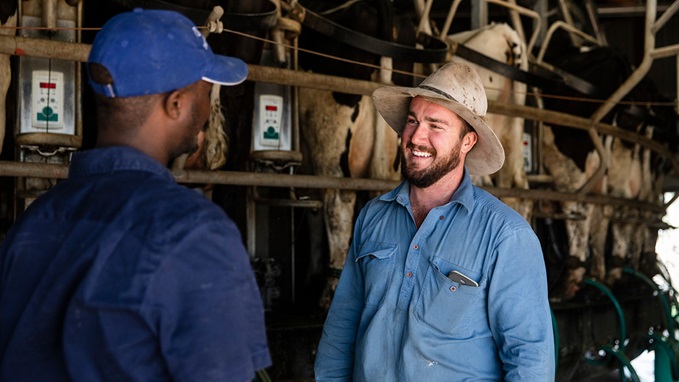Farm Safety & Wellbeing
Dairy Australia has created a suite of tools and resources to help farmers develop a comprehensive safety system on their farm and work toward the industry goal of zero fatalities on dairy farms.
Below are some practical resources, designed and tested by dairy farmers to apply on-farm.
Farm Safety Starter Kit
Developed by dairy farmers for dairy farmers, the Farm Safety Starter Kit provides practical, easy-to-use resources to enable dairy farmers to start their farm safety system or improve an existing system. The kit contains:
- Farm safety induction: a checklist on key areas to be covered for new employees and roles and responsibilities for farm managers and employees.
- Safety system snapshot: a ‘traffic lights’ format which compares a farm system to the law.
- Quick safety scans: a set of one page scans on the key hazard areas on a dairy farm.
- Injury and incident register: a ready-to-use template to record incident information.
- Action plan: to plan follow up on areas that need to be fixed or improved.
Read the Farm Safety Starter Kit or order a Farm Safety Starter Kit.
Farm Safety Manual
The Farm Safety Manual is a step by step approach to build a safety system for dairy farms and keep this system maintained. Work through the sections at your own pace, building your farm safety system as you go.
The Farm Safety Manual provides information, documents and templates relating to 15 areas on farm:
- Getting Started
- Quad and Motorbikes
- Farm Vehicles
- Tractors and Mobile Plant
- Fixed Plant
- Contractors
- Confined Spaces
- Working at Heights
- Power and Electrical
- Manual Handling
- Working with Livestock
- Farm Chemicals
- Water and Effluent
- Working Environment
- Visitors, Children and Traffic
Read the Farmer Safety Manual on The People In Dairy.
Farm safety workshops
Through its regional teams, Dairy Australia runs workshops and events for farmers to upskill themselves and their farm workers on technical and non-technical aspects of farming.
Gippsland dairy farmer Trish Hammond has developed safety system on her farm and reminds her kids – Dane, Amber and Lara – about the importance of safety on their 650 cow farm.
For more information on farm safety workshops in your region,
Check Dairy Australia's events calendar.
Legal requirements for safety
Employers are required to provide every employee with a safe and risk-free workplace.
Employees are required to take steps to protect their own health and safety by following safety instructions and using safe equipment.
Registering injuries and accidents
Any person injured on a farm, regardless of whether it is a minor or major injury, must:
- Report the injury or work-related illness to their supervisor or employer as soon as possible.
- Enter details in the farm's Injury and Incident Register or have another person complete the Register on their behalf.
- When the injury requires treatment, obtain a Workcover medical certificate from the treating doctor and provide this certificate to the employer.
Investigate accidents
All work-related injuries, accidents and incidents need to be investigated as soon as possible to determine the cause(s) and identify actions necessary to prevent it happening again.
Top farm safety tips
- Ensure regular equipment maintenance by suitably qualified persons.
- Apply parking brakes on vehicles.
- Adequate guarding on PTO shafts and belt drives.
- When working alone, let others know where you plan to be
- Use correct equipment that is in good working order.
- Be very careful when working near moving machinery and vehicles.
- Watch out for overhead power lines.
- Set the example for safe conduct.
- Have staff inducted, trained and aware about safety.
- Use effective harnesses when working at heights and fall protection equipment.
- Wear helmets when driving open vehicles, quad bikes and motorbikes.
- Think about children and keep them away from work sites.
- Think safety and operate within limitations.
Eski: Safety Checklist
These questions can be used as a starting point to improving on-farm safety.
- Is there an induction process for employees, contractors and visitors?
- Is there a workplace health and safety policy and are there procedures that are followed for all tasks?
- Is there a documented risk management process that includes manual handling, chemicals, plant, confined spaces, working at height and electrical?
- Is there a consultation/communication system with employees?
- Is there an emergency response plan for the farm?
- Is there a documented process for hazard, accident and incident reporting?
- Are there adequate amenities for people in the workplace?
- Do workers possess licences and/or certificates of competency for the plant they operate and tasks they undertake? For example, forklift licence, driver’s licence, chemical user’s certificate.
- Does all plant and equipment used in the workplace comply with regulations, including guarding, noise, design, maintenance and use?
- Is there a process for managing work environment hazards including noise, dust, hot and cold conditions and sun exposure?
- Has child safety in the workplace been addressed?
- Are chemicals managed correctly – records, storage, personal protective equipment, usage, material safety data sheets, signage?
- Is there adequate signage in the workplace? For example, visitor directions, traffic movement, specific hazards, use of personal protective equipment, general warnings.
- Does personal protective equipment meet legal requirements – quality, comfort, storage, maintenance, usage?
- Is there a policy/procedure which enables people working in remote and isolated locations to receive assistance in emergency situations
Health and wellbeing
Emotional resilience is being willing to accept there will be good and bad times, understanding reactions to these experiences, and having strategies to manage them.
Resilience is a process, not a trait of an individual or an event. It takes preparation and practice to develop and maintain emotional resilience. Being resilient does not mean a person won't experience difficulty or stress.
It describes an individual's tendency to cope with stress and adversity as a result of their processes, behaviours, thoughts and actions.
DEPRESSION
Depression is a mood disorder is characterised by an unusually persistent sad mood that does not go away, a loss of enjoyment and interest in once pleasurable activities, a lack of energy and tiredness.
It is helpful for people to understand what depression is and what it isn't. It is not something to be ashamed of or to feel guilty about.
Farmers can be more vulnerable because of:
- Intense periods of work
- Lack of sleep
- Isolation
- Lower exercise levelsServices not readily available
- Self-sufficiency and independent attitude
- 'Just get on with it' attitude
- The stigma around mental illness and a general reluctance to seek help.
SPEAK TO SOMEONE
National Centre for Farmer Health
www.farmerhealth.org.au
Centre for Rural and Remote Mental Health
www.crrmh.com.au
Rural Financial Counselling Service
1800 686 175
www.agriculture.gov.au
Lifeline
13 11 14
www.lifeline.org.au
Beyondblue
1300 224 636
www.beyondblue.org.au
Black Dog Institute
www.blackdoginstitute.org.au
Headspace
1800 650 890
headspace.org.au
To request a hardcopy of the ESKi - for a hardcopy, please contact your regional team.


